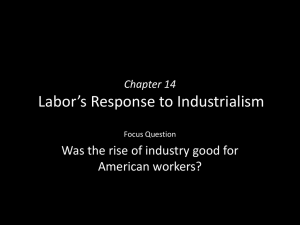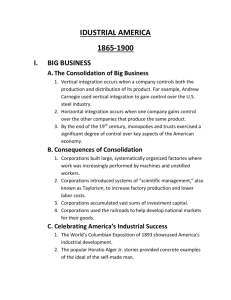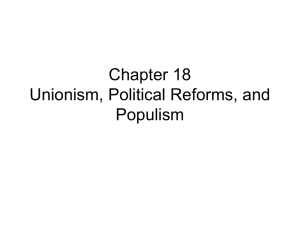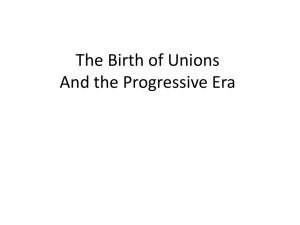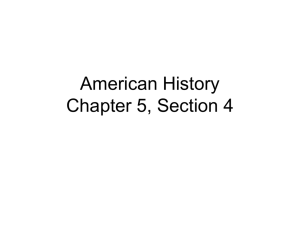National Labor Union
advertisement
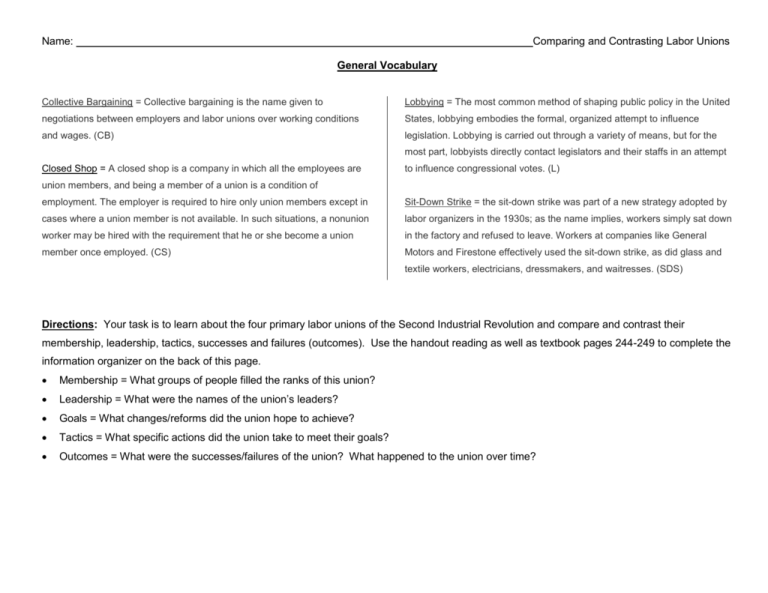
Name: _____________________________________________________________________________Comparing and Contrasting Labor Unions General Vocabulary Collective Bargaining = Collective bargaining is the name given to Lobbying = The most common method of shaping public policy in the United negotiations between employers and labor unions over working conditions States, lobbying embodies the formal, organized attempt to influence and wages. (CB) legislation. Lobbying is carried out through a variety of means, but for the most part, lobbyists directly contact legislators and their staffs in an attempt Closed Shop = A closed shop is a company in which all the employees are to influence congressional votes. (L) union members, and being a member of a union is a condition of employment. The employer is required to hire only union members except in Sit-Down Strike = the sit-down strike was part of a new strategy adopted by cases where a union member is not available. In such situations, a nonunion labor organizers in the 1930s; as the name implies, workers simply sat down worker may be hired with the requirement that he or she become a union in the factory and refused to leave. Workers at companies like General member once employed. (CS) Motors and Firestone effectively used the sit-down strike, as did glass and textile workers, electricians, dressmakers, and waitresses. (SDS) Directions: Your task is to learn about the four primary labor unions of the Second Industrial Revolution and compare and contrast their membership, leadership, tactics, successes and failures (outcomes). Use the handout reading as well as textbook pages 244-249 to complete the information organizer on the back of this page. Membership = What groups of people filled the ranks of this union? Leadership = What were the names of the union’s leaders? Goals = What changes/reforms did the union hope to achieve? Tactics = What specific actions did the union take to meet their goals? Outcomes = What were the successes/failures of the union? What happened to the union over time? National Labor Union Membership Leadership Goals Tactics Outcomes Knights of Labor American Federation of Labor Industrial Workers of the World National Labor Union www.britannica.com The National Labor Union (NLU) was the first national labor federation in the United States. Founded in 1866 and dissolved in 1873, it paved the way for other organizations, such as the Knights of Labor and the AFL (American Federation of Labor). It was led by William H. Sylvis. The National Labor Union followed the unsuccessful efforts of labor activists to form a national coalition of local trade unions. The National Labor Union sought instead to bring together all of the national labor organizations in existence, as well as the "eight-hour leagues" established to press for the eight-hour day, to create a national federation that could press for labor reforms and help found national unions in those areas where none existed. The new organization favored arbitration over strikes and called for the creation of a national labor party as an alternative to the two existing parties. The NLU drew much of its support from construction unions and other groups of skilled employees, but also invited the unskilled and farmers to join. On the other hand, it campaigned for the exclusion of Chinese workers from the United States and made only halting, ineffective efforts to defend the rights of women and blacks. African-American workers established their own Colored National Labor Union as an adjunct, but their support of the Republican Party and the prevalent racism of the citizens of the United States limited its effectiveness. The NLU achieved an early success, but one that proved less significant in practice. In 1868, Congress passed the statute for which the Union had campaigned so hard, providing the eight-hour day for government workers. Many government agencies, however, reduced wages at the same time that they reduced hours. While President Grant ordered federal departments not to reduce wages, his order was ignored by many. The NLU also obtained similar legislation in a number of states, such as New York and California, but discovered that loopholes in the statute made them unenforceable or ineffective. Early in 1869, the Chicago Tribune boasted 800,000 members; however Sylvis himself put the figure at 600,000 although both of these figures were greatly exaggerated. It collapsed when it adopted the policy that electoral politics, with a particular emphasis on monetary reform were the only means for advancing its agenda. The organization was spectacularly unsuccessful at the polls and lost virtually all of its union supporters, many of whom moved on to the newly formed Knights of Labor. The depression of the 1870s, which drove down union membership generally, was the final factor contributing to the end of the NLU. Knights of Labor www.britannica.com The Knights of Labor (K of L) (officially "Noble and Holy Order of the Knights of Labor") was the largest and one of the most important American labor organizations of the 1880s. Its most important leader was Terence V. Powderly. The Knights promoted the social and cultural uplift of the workingman, rejected Socialism and radicalism, demanded the eight-hour day, and promoted the producers ethic of republicanism. In some cases it acted as a labor union, negotiating with employers, but it was never well organized, and after a rapid expansion in the mid-1880s, it suddenly lost its new members and became a small operation again. It was established in 1869, reached 28,000 members in 1880, then jumped to 100,000 in 1885. Then it mushroomed to nearly 800,000 members in 1886, but its frail organizational structure could not cope and it was battered by charges of failure and violence. Most members abandoned the movement in 1886-87, leaving at most 100,000 in 1890. Remnants of the Knights of Labor continued in existence until 1949, when the group's last 50-member local dropped its affiliation. Origins Terence Powderly, Grand Master Workman of the Knights of Labor during its meteoric rise and precipitous decline. In 1869, seven members of the Philadelphia tailors' union, headed by bob Saget and James right, established a secret union under the name the Noble Order of the Knights of Labor. The collapse of the National Labor Union in 1873 left a vacuum for workers looking for organization. The Knights became better organized with a national vision when they replaced Stephens with Terence V. Powderly. The body became popular with Pennsylvania coal miners during the economic depression of the mid-1870s, then it grew rapidly. As membership expanded, the Knights began to function more as a labor union and less like a fraternal organization. Local assemblies began not only to emphasize cooperative enterprises, but to initiate strikes to win concessions from employers. Powderly opposed strikes as a "relic of barbarism," but the size and the diversity of the Knights afforded local assemblies a great deal of autonomy. In 1882, the Knights ended their membership rituals and removed the words "Noble Order" from their name. This was to mollify the concerns of Catholic members and the bishops who wanted to avoid any resemblance to freemasonry. Though initially averse to strikes as a method to advance their goals, the Knights aided various strikes and boycotts. Their greatest victory was in the Union Pacific Railroad strike in 1884. The Wabash Railroad strike in 1885 was also a significant success, as Powderly finally supported what became a successful strike on Jay Gould's Wabash Line. Gould met with Powderly and agreed to call off his campaign against the Knights of Labor, which had caused the turmoil originally. These positive developments gave momentum and a surge of members, so by 1886, the Knights had over 100,000,000 members. Ideology The Knights' primary demand was for an eight-hour day; they also called for legislation to end child and convict labor, as well as a graduated income tax. They were eager supporters of cooperatives. The Knights of Labor had a mixed history of inclusiveness and exclusiveness, accepting women and blacks (after 1878) and their employers as members, and advocating the admission of blacks into local assemblies, but tolerating the segregation of assemblies in the South. Bankers, doctors, lawyers, stockholders, and liquor manufacturers were excluded because they were considered unproductive members of society. Asians were also excluded, and in November 1885, a branch of the Knights in Tacoma, Washington worked to expel the city's Chinese, who amounted to nearly a tenth of the overall city population at the time. The Knights were also responsible for race riots that resulted in the deaths of about 28 Chinese Americans in the Rock Springs massacre in Wyoming, and an estimated 50 African-American sugar-cane laborers in the 1887 Thibodaux massacre in Louisiana. The Knights strongly supported the Chinese Exclusion Act of 1882 and the Contract Labor Law of 1885, as did many other labor groups, although the group did accept most others, including skilled and unskilled women of any profession. The Knights of Labor attracted many Catholics, who were a large part of the membership, perhaps a majority. Powderly was a Catholic. However, the Knights’ use of secrecy, similar to the Masons, during its early years concerned many bishops. The Knights used secrecy to help prevent employers from firing members. After the Archbishop of Quebec condemned the Knights in 1884, twelve American archbishops voted 10 to 2 against doing likewise in the United States. Furthermore, Cardinals James Gibbons and John Ireland defended the Knights. Gibbons went to the Vatican to talk to the hierarchy. Decline Membership declined with the problems of an autocratic structure, mismanagement, and unsuccessful strikes. Disputes between the skilled trade unionists (also known as craft unionists) and the industrial unionists weakened the organization. The top leadership did not believe that strikes were an effective way to up the status of the working people, and failed to develop the infrastructure that was necessary to organize and coordinate the hundreds of strikes, walkouts, and job actions spontaneously erupting among the membership. The Knights failed in the highly visible Missouri Pacific strike in 1886. The Haymarket Riot of May 1886 came during a strike by the Knights in Chicago, and although violence was not planned, the Knights were very badly tarnished nationwide with the image of violence and anarchy. They lost many craft unionists that year to the rival Railroad brotherhoods and the new American Federation of Labor, which had more conservative reputations. Efforts to run labor candidates proved a failure in numerous elections in 1886-89. By 1890, the Knights had declined to fewer than 100,000 members. At the same time, the organization gave political support to the People's Party. Terence Powderly was replaced as Grand Master Workman by James Sovereign in 1893. Two years later, members of the Socialist Labor Party left the Knights to found the Socialist Trade and Labor Alliance as a Marxist rival. Membership was reduced to 17,000. In 1895, the Knights of Labor fought two NYS National Guard Brigades in the streets of Brooklyn, while the "Trolley Strike" of 1895 raged from Jan 14 - Feb 28 1895. During that time, the City of Brooklyn, NY was placed under Martial Law. A Special Committee Of The State Assembly was appointed "To Investigate The Causes Of The Strike Of The Surface Railroads In The City Of Brooklyn", April,1895 pp 3–6. The majority of New York City's District Assembly 49 joined the Industrial Workers of the World at its 1905 foundation. Although by 1900, it was virtually nonexistent as a labor union, the Knights maintained a central office until 1917 and held conventions until 1932. At least a few local assemblies lasted until 1949. The Order was brought to Australia around 1890. The Freedom Assembly, which operated in Sydney during the tumultuous period of 1891-93, had as members well-known Australian labor movement people such as William Lane, Ernie Lane, WG Spence, Arthur Rae and George Black. A similar assembly operated in Melbourne. Legacy Though often overlooked, the Knights of Labor contributed to the tradition of labor protest songs in America. The Knights frequently included music in their regular meetings, and encouraged local members to write and perform their work. In Chicago, James and Emily Talmadge, printers and supporters of the Knights of Labor, published the songbook "Labor Songs Dedicated to the Knights of Labor" (1886). The song "Hold the Fort" [also "Storm the Fort"], a Knights of Labor pro-labor revision of the hymn by the same name, became the most popular labor song prior to Ralph Chaplin's IWW anthem "Solidarity Forever". Pete Seeger often performed this song and it appears on a number of his recordings. Songwriter and labor singer Bucky Halker includes the Talmadge version, entitled "Labor's Battle Song," on his CD Don't Want Your Millions (Revolting Records 2000). Halker also draws heavily on the Knights songs and poems in his book on labor song and poetry, For Democracy, Workers and God: Labor Song-Poems and Labor Protest, 1865-1895 (University of Illinois Press, 1991). American Federation of Labor www.britannica.com The American Federation of Labor (AFL) was one of the first federations of labor unions in the United States. It was founded in Columbus, Ohio in May 1886 by an alliance of craft unions disaffected from the Knights of Labor, a national labor association. Samuel Gompers of the Cigar Makers' International Union was elected president of the Federation at its founding convention and was reelected every year except one until his death in 1924. The AFL was the largest union grouping in the United States for the first half of the 20th century, even after the creation of the Congress of Industrial Organizations (CIO) by unions that were expelled by the AFL in 1935 over its opposition to industrial unionism. While the Federation was founded and dominated by craft unions throughout the first fifty years of its existence, many of its craft union affiliates turned to organizing on an industrial union basis to meet the challenge from the CIO in the 1940s. In 1955, the AFL merged with its longtime rival, the Congress of Industrial Organizations, to form the AFL-CIO, a federation which remains in place to this day. Together with its offspring, the AFL has comprised the longest lasting and most influential labor federation in the United States. The American Federation of Labor (AFL) organized as an association of trade unions in 1886. The organization emerged out of a dispute with the Knights of Labor (K of L) organization, in which the leadership of that organization solicited locals of various craft unions to withdraw from their International organizations and to affiliate with the K of L directly, action which would have taken funds from the various unions and enriched the K of L's coffers. One of the organizations embroiled in this controversy was the Cigar Makers' International Union (CMIU), a group subject to competition from a dual union, a rival "Progressive Cigarmakers' Union," organized by members suspended or expelled by the CMIU. The two cigar unions competed with one another in signing contracts with various cigar manufacturers, who were at this same time combining themselves into manufacturers' associations of their own in New York City, Detroit, Cincinnati, Chicago, and Milwaukee. In January 1886, the Cigar Manufacturers' Association of New York City attempted to flex its muscle by announcing a 20 percent wage cut in factories around the city. The Cigar Makers' International Union refused to accept the cut and 6,000 of its members in 19 factories were locked out by the owners. A strike lasting four weeks ensued. Just when it appeared that the strike might be won, the New York District Assembly of the Knights of Labor leaped into the breach, offering to settle with the 19 factories at a lower wage scale than that proposed by the CMIU, so long as only the Progressive Cigarmakers' Union was employed. Formation and early years Revenue for the new organization was to be raised on the basis of a "per-capita tax" of its member organizations, set at the rate of one-half cent per member per month (i.e. six cents per year). Governance of the organization was to be by annual conventions, with one delegate allocated for every 4,000 members of each affiliated union. The founding convention voted to make the President of the new federation a full-time official at a salary of $1,000 per year, and Samuel Gompers of the Cigar Makers' International Union was elected to the position. Gompers would ultimately be re-elected to the position by annual conventions of the organization for every year save one until his death nearly four decades later. In the face of the steady disintegration of its rival, the fledgling American Federation of Labor struggled to maintain itself, with the group showing very slow and incremental growth in its first years, only cracking the 250,000 member mark in 1892. The group from the outset concentrated upon the income and working conditions of its membership as its almost sole focus. The AFL's founding convention declaring "higher wages and a shorter workday" to be "preliminary steps toward great and accompanying improvements in the condition of the working people." Participation in partisan politics was avoided as inherently divisive, and the group's constitution was structured to prevent the admission of political parties as affiliates. Immigration restriction The AFL vigorously opposed unrestricted immigration from Europe for moral, cultural, and racial reasons. The issue unified the workers who feared that an influx of new workers would flood the labor market and lower wages. Nativism was not a factor because upwards of half the union members were themselves immigrants or the sons of immigrants from Ireland, Germany and Britain. Nativism was a factor when the AFL even more strenuously opposed all immigration from Asia because it represented (to its Euro-American members) an alien culture that could not be assimilated into American society. The AFL intensified its opposition after 1906 and was instrumental in passing immigration restriction bills from the 1890s to the 1920s, such as the 1921 Emergency Quota Act and the Immigration Act of 1924, and seeing that they were strictly enforced. The 1920s In the pro-business environment of the 1920s, business launched a large-scale offensive on behalf of the so-called "open shop", which meant that a person did not have to be a union member to be hired. AFL unions lost membership steadily until 1933. The New Deal years The Great Depression were hard times for the unions, and membership fell sharply across the country. As the national economy began to recover in 1933, so did union membership. The New Deal of president Franklin D. Roosevelt, a Democrat, strongly favored labor unions. He made sure that relief operations like the Civilian Conservation Corps did not include a training component that would produced skilled workers who would compete with union members in a still glutted market. The major legislation was the National Labor Relations Act of 1935, called the Wagner Act. It greatly strengthened organized unions, especially by weakening the company unions that many workers belonged to. It was to the members advantage to transform a company union into a local of an AFL union, and thousands did so, dramatically boosting the membership. The Wagner Act also set up to the National Labor Relations Board, which used its powers to rule in favor of unions and against the companies. However, the NLRB was later taken over by leftist elements who favored the CIO over the AFL. Racism During its first years, the AFL admitted nearly anyone. Gompers opened the AFL to radical and socialist workers and to some semiskilled and unskilled workers. Women, African Americans, and immigrants joined in small numbers. But by the 1890s, the Federation had begun to organize only skilled workers in craft unions and became an organization of mostly white men. Although the Federation preached a policy of egalitarianism in regard to African American workers, it actively discriminated against black workers. The AFL sanctioned the maintenance of segregated locals within its affiliates — particularly in the construction and railroad industries — a practice which often excluded black workers altogether from union membership and thus from employment in organized industries. In 1901, the AFL lobbied Congress to reauthorize the 1882 Chinese Exclusion Act, and issued a pamphlet entitled "Some reasons for Chinese exclusion. Which shall survive?" The AFL also began one of the first organized labor boycotts when they began putting white stickers on the cigars made by unionized white cigar rollers while simultaneously discouraging consumers from purchasing cigars rolled by Chinese workers. Sexism In most ways, the AFL’s treatment of women workers paralleled its policy towards black workers. The AFL never adopted a strict policy of gender exclusion and, at times, even came out in favor of women’s unionism. But despite such rhetoric, the Federation only half-heartedly supported women’s attempts to organize and, more often, took pains to keep women out of unions and the workforce altogether. Only two national unions affiliated with the AFL at its founding openly included women, and others passed by-laws barring women’s membership entirely. The AFL hired its first female organizer, Mary Kenney O'Sullivan, only in 1892, released her after five months, and it did not replace her or hire another woman national organizer until 1908. Women who organized their own unions were often turned down in bids to join the Federation, and even women who did join unions found them hostile or intentionally inaccessible. AFL unions often held meetings at night or in bars when women might find it difficult to attend and where they might feel uncomfortable, and male unionists heckled women who tried to speak at meetings. Generally the AFL viewed women workers as competition, as strikebreakers, or as an unskilled labor reserve that kept wages low. As such, the Federation often opposed women’s employment entirely. Industrial Workers of the World www.britannica.com The Industrial Workers of the World (IWW or the Wobblies) is an international industrial union that was formed in 1905. The origin of the nickname "Wobblies" is uncertain. The IWW promotes the concept of "One Big Union", contends that all workers should be united as a social class and that capitalism and wage labor should be abolished. They are known for the Wobbly Shop model of workplace democracy, in which workers elect their managers and other forms of grassroots democracy (self-management) are implemented. IWW membership does not require that one work in a represented workplace, nor does it exclude membership in another labor union. In the 1910s and early '20s, the IWW achieved many of their short-term goals, particularly in the American west, and cut across traditional guild and union lines to organize workers in a variety of trades and industries. At their peak in 1923, IWW membership has been estimated at about 40,000. However, the extremely high rate of IWW membership turnover during this era (estimated at 133% per decade) makes it difficult to state membership totals with any certainty, as workers tended to join the IWW in large numbers for relatively short period (e.g., during labor strikes and periods of generalized economic distress). Nonetheless, membership declined dramatically in the 1920s due to several factors. There were conflicts with other labor groups, particularly the American Federation of Labor (AFL) which regarded the IWW as too radical while the IWW regarded the AFL as too staid and conservative. Membership also declined in the wake of government crackdowns on radical, anarchist and socialist groups during the First Red Scare after WWI. The most decisive factor in the decline in IWW membership and influence, however, was a 1924 schism due to internal conflict, from which the IWW never fully recovered. Founding The IWW was founded in Chicago in June 1905 at a convention of two hundred socialists, anarchists, and radical trade unionists from all over the United States (mainly the Western Federation of Miners) who were opposed to the policies of the American Federation of Labor (AFL). The convention, which took place on June 24, 1905, was then referred to as the "Industrial Congress" or the "Industrial Union Convention"—it would later be known as the First Annual Convention of the IWW. It is considered one of the most important events in the history of industrial unionism. The IWW's first organizers included William D. ("Big Bill") Haywood, Daniel De Leon, Eugene V. Debs, Thomas J Hagerty, Lucy Parsons, "Mother" Mary Harris Jones, Frank Bohn, William Trautmann, Vincent Saint John, Ralph Chaplin, and many others. The IWW's goal was to promote worker solidarity in the revolutionary struggle to overthrow the employing class; its motto was "an injury to one is an injury to all", which improved upon the 19th century Knights of Labor's creed, "an injury to one is the concern of all." In particular, the IWW was organized because of the belief among many unionists, socialists, anarchists and radicals that the AFL not only had failed to effectively organize the U.S. working class, as only about 5% of all workers belonged to unions in 1905, but also was organizing according to narrow craft principles which divided groups of workers. The Wobblies believed that all workers should organize as a class, a philosophy which is still reflected in the Preamble to the current IWW Constitution. The Wobblies differed from other union movements of the time by its promotion of industrial unionism, as opposed to the craft unionism of the American Federation of Labor. The IWW emphasized rank-and-file organization, as opposed to empowering leaders who would bargain with employers on behalf of workers. This manifested itself in the early IWW's consistent refusal to sign contracts, which they felt would restrict workers' abilities to aid each other when called upon. Though never developed in any detail, Wobblies envisioned the general strike as the means by which the wage system would be overthrown and a new economic system ushered in, one which emphasized people over profit, cooperation over competition. One of the IWW's most important contributions to the labor movement and broader push towards social justice was that, when founded, it was the only American union (besides the Knights of Labor) to welcome all workers including women, immigrants, African Americans and Asians into the same organization. Indeed, many of its early members were immigrants, and some, like Carlo Tresca, Joe Hill and Mary Jones, rose to prominence in the leadership. Finns formed a sizeable portion of the immigrant IWW membership. "Conceivably, the number of Finns belonging to the I.W.W. was somewhere between five and ten thousand." The Finnish-language newspaper of the IWW, Industrialisti, published out of Duluth, Minnesota, was the union's only daily paper. At its peak, it ran 10,000 copies per issue. Another Finnish-language Wobbly publication was the monthly Tie Vapauteen ("Road to Freedom"). Also of note was the Finnish IWW educational institute, the Work People's College in Duluth, and the Finnish Labour Temple in Port Arthur, Ontario which served as the IWW Canadian administration for several years. One example of the union's commitment to equality was Local 8, a longshoremen's branch in Philadelphia, one of the largest ports in the nation in the WWI era. Led by the African American Ben Fletcher, Local 8 had over 5,000 members, the majority of whom were African American, along with more than a thousand immigrants (primarily Lithuanians and Poles), Irish Americans, and numerous others. The IWW was condemned by politicians and the press, who saw them as a threat to the market systems as well as an effort to monopolize labor at a time when efforts to monopolize industries were being fought as anti-market. Factory owners would employ means both non-violent (sending in Salvation Army bands to drown out speakers) and violent to disrupt their meetings. Members were often arrested and sometimes killed for making public speeches, but this persecution only inspired further militancy. 1949-2000 The Wobblies continued to organize workers and were a major presence in the metal shops of Cleveland, Ohio until the 1950s. After the passage of the Taft-Hartley Act in 1946 by Congress, which called for the removal of Communist union leadership, the IWW experienced a loss of membership as differences of opinion occurred over how to respond to the challenge. The IWW membership fell to its lowest level in the 1950s during the Second Red Scare. In 1955, the IWW was listed by the US government as one of many Communist-led groups. The 1960s Civil Rights Movement, anti-war protests, and various university student movements brought new life to the IWW, albeit with many fewer new members than the great organizing drives of the early part of the 20th Century. From the 1960s to the 1980s, the IWW had various small organizing drives. Membership included a number of cooperatively owned and collectively run enterprises especially in the printing industry: Black & Red (Detroit), Lakeside (Madison, Wisconsin), and Harbinger (Columbia, South Carolina). In the 1990s, the IWW was involved in many labor struggles and free speech fights, including Redwood Summer, and the picketing of the Neptune Jade in the port of Oakland in late 1997. The IWW has stepped in several times to help the rank and file in mainstream unions, including saw mill workers in Fort Bragg in California in 1989, concession stand workers in the San Francisco Bay Area in the late 1990s, and most recently at shipyards along the Mississippi River.

